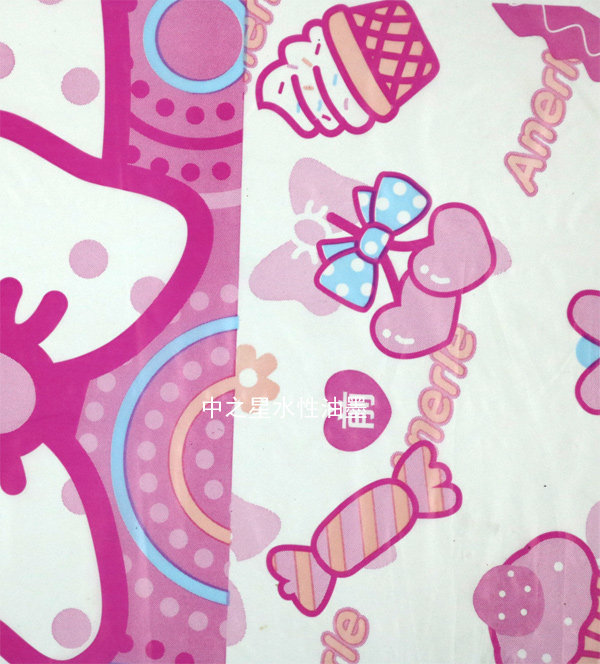How to improve the adhesion of non-woven water-based ink by adjusting the process parameters
Date: Feb 21 2024 From: Star Color Views:
As an environmentally friendly printing material, non-woven water-based ink is more and more widely used in packaging, advertising, decoration and other fields.However, in practical applications, the adhesion problem of
non-woven water-based ink often becomes a key factor restricting its application effect.Therefore, how to improve the adhesion of non-woven water-based ink by adjusting the process parameters has become the focus of current research.In this paper, based on the adhesion mechanism of non-woven water-based ink, the main factors affecting the adhesion are analyzed, and the corresponding adjustment strategies of process parameters are proposed, in order to provide a useful reference for improving the adhesion of non-woven water-based ink.
Adhesion mechanism of non-woven water-based ink
The adhesion of non-woven water-based ink refers to the binding force between the ink film formed by the ink on the surface of the non-woven fabric and the non-woven substrate.Good adhesion is the basis for ensuring the quality and service life of printed matter.The adhesion mechanism of non-woven water-based ink mainly includes two aspects: physical adsorption and chemical binding.Physical adsorption refers to the formation of a layer of adhesion film on the surface of the non-woven fabric through the physical action of the intermolecular van der Waals force and other polymers in the ink.Chemical bonding refers to the chemical reaction between some functional groups in the ink and functional groups such as hydroxyl and carboxyl groups on the surface of the non-woven fabric to form chemical bonding, thereby enhancing adhesion.
The main factors affecting the adhesion of non-woven water-based ink

Non-woven surface properties: the surface roughness, wettability, surface energy and other properties of non-woven fabrics have an important impact on the adhesion of ink.The greater the surface roughness, the more difficult it is for the ink to completely fill the uneven surface of the non-woven fabric, and the adhesion is reduced.The higher the surface energy of the non-woven fabric, the stronger the interaction force between it and the ink, the better the adhesion.
Ink properties: non-woven water-based ink viscosity, surface tension, drying speed and other properties will also affect its adhesion.The appropriate viscosity helps the ink to form a uniform ink film on the surface of the non-woven fabric, and the surface tension affects the wetting and spreading of the ink on the surface of the non-woven fabric.Excessive drying speed may lead to increased internal stress of the ink and reduced adhesion.
Printing process parameters: printing pressure, printing speed, drying temperature and other process parameters also have a significant impact on the adhesion of non-woven water-based ink.Insufficient printing pressure may cause the ink to not penetrate fully into the interior of the non-woven fabric, and the adhesion is reduced;The printing speed is too fast, which may cause the ink to leave the surface of the non-woven fabric when it is not completely dry, affecting the adhesion.Too high or too low drying temperature may affect the degree of curing of the ink, thus affecting the adhesion.
Adjust the process parameters to improve the adhesion of non-woven water-based ink
In view of the above influencing factors, we can improve the adhesion of non-woven water-based ink by adjusting the following process parameters:
Adjust the printing pressure: appropriately increase the printing pressure, so that the ink can more fully penetrate into the non-woven interior, improve the ink and non-woven binding force.However, attention should be paid to avoid excessive pressure leading to deformation or damage of non-woven fabrics.
Control the printing speed: under the premise of ensuring the printing quality, the printing speed is properly reduced, so that the ink has more adequate drying time on the surface of the non-woven fabric, so as to improve the adhesion.
Adjust the drying temperature: according to the drying characteristics of the ink and the heat resistance of the non-woven fabric, choose the appropriate drying temperature.High temperature may cause the ink to dry too fast, produce internal stress, reduce adhesion;Too low temperature may lead to incomplete ink drying, affecting adhesion.Therefore, it is necessary to explore and adjust continuously in actual operation to find the best drying temperature.
Optimize the ink formula: according to the surface properties of non-woven fabrics and printing requirements, optimize the ink formula and improve the interaction between ink and non-woven fabrics.For example, an appropriate amount of surfactant or coupling agent can be added to improve the wettability and spreadability of the ink on the surface of the non-woven fabric and improve the adhesion.
Surface treatment: The non-woven surface is pre-treated, such as corona treatment, plasma treatment, etc., to change its surface properties and improve its binding force with ink.
In order to verify the effectiveness of the above process parameter adjustment strategy, a series of practical application cases were analyzed.In a packaging and printing enterprise, we found that the adhesion of products printed with non-woven water-based ink was poor, resulting in problems such as falling off and blurring in the use of printed matter.To solve this problem, we have adjusted the printing process parameters according to the above strategy.By appropriately increasing the printing pressure, reducing the printing speed, adjusting the drying temperature and optimizing the ink formula, we found that the adhesion of non-woven water-based inks has been significantly improved.In practical applications, the adjusted printed matter has stable adhesion and can meet the requirements of customers.
Based on the analysis of adhesion mechanism and influencing factors of water-based inks for non-woven fabrics, this paper puts forward the strategy of improving adhesion of water-based inks for non-woven fabrics by adjusting process parameters.Practical application cases show that these strategies are effective.However, the adhesion of non-woven water-based inks is still a complex research area, which needs further exploration and research.

 RU
RU
 EN
EN
 CN
CN


